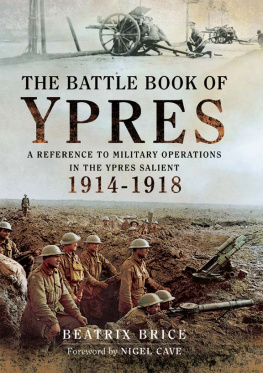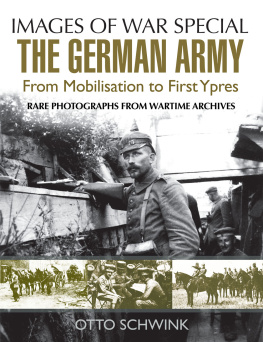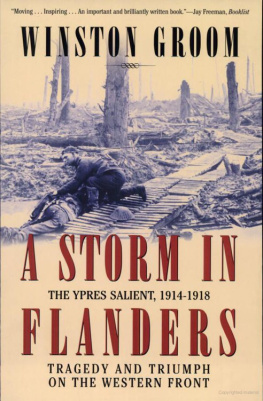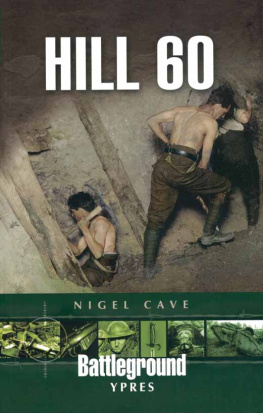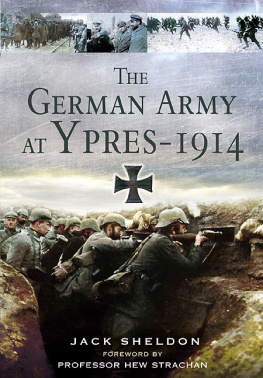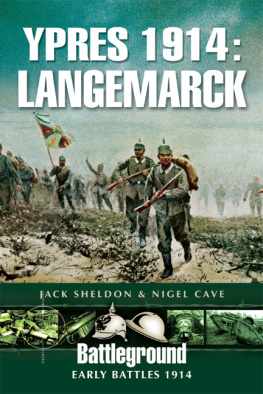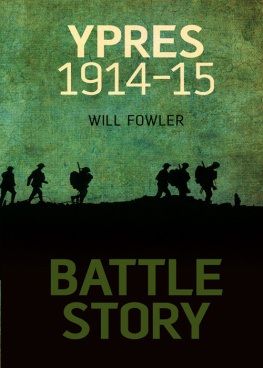THE BATTLE BOOK OF YPRES
THE SALIENT.
Hold!
From a drawing by Captain Ernest H. Shepard, M.C.
[Frontispiece
THE
BATTLE BOOK OF YPRES
COMPILED BY BEATRIX BRICE
WITH THE ASSISTANCE OF
LIEUT.-GENERAL SIR WILLIAM PULTENEY, K.C.B., ETC.
AND WITH A FOREWORD BY
FIELD-MARSHAL THE LORD PLUMER OF MESSINES, G.C.B., ETC.
SPA BOOKS in association with
TOM DONOVAN MILITARY BOOKS
John Murray Publishers Ltd, 1987 (First Published 1927)
All rights reserved. No part of this publication may be reproduced, stored in a retrieval
system or transmitted in any form by any means, electrical, mechanical or otherwise without
first seeking the written permission of the copyright owner and of the publisher.
ISBN: 0907590179
Publishing History: This work was first issued in 1927 and has been out of print for
many years. This edition reproduces the original text complete and unabridged except
for the substitution of a new, annotated bibliography and the inclusion of some previously
unpublished contemporary photographs.
This edition first published 1987, reprinted 1988
Published by SPA BOOKS LTD in association with
TOM DONOVAN PUBLISHING LTD
PO Box 47
STEVENAGE
Herts SG2 8UH
Printed in Great Britain at The Bath Press, Avon
FOREWORD
BY FIELD-MARSHAL THE LORD PLUMER OF MESSINES, G.C.B., ETC.
THE inception of this book was the desire to publish a memorial book of Ypres in furtherance of the aims of the Ypres League; To perpetuate the tradition of the four years defence of the Salient as an ideal, and a source of inspiration for all time.
A letter was addressed to every Regiment in the British Army, signed by the late Field-Marshal the Earl of Ypres, General Sir Charles Harington, and myself, in which we asked for an account of some outstanding achievement that the Regiment would specially wish commemorated in the Ypres Salient. We said that we wished in this way to make a very distinctive book; one that should be a memorial both in the Regiments and in the families of the soldiers, and that it would give expression to our thought that Ypres does not stand for a ruined town, but for a very high ideal built up by the lives of men. Miss Beatrix Brice was asked to undertake the work of compilation, as she has devoted her writings to soldier themes since her poem The Vanguard 14 led to the first general recognition by the people of what their country owes to the First Seven Divisions.
An enthusiastic response was received from the regiments, most of whom sent us contributions, but unfortunately these proved to be somewhat similar in characterdescriptions of fine engagements, seen from a purely military view. A collection of these would only have repeated the work of regimental and divisional historians. It was therefore decided to include the gist of these accounts, and also to gather together narratives of outstanding deeds from authoritative sources.
The welcome extended to The Immortal Salient, the historical guide to Ypres, pointed clearly to the most acceptable form for the new book, i.e. a sequel that would fill every sector of the Salient with the fuller story of the great events that took place there.
We wish to stress the fact that no attempt is made to choose the finest deeds that were performed at each place, nor to extol the achievement of one unit more than another. The narratives given are of a variety of episodes and conditions, chosen as representative, so as to create a vivid picture of what was meant by battle fighting in the awful and immortal Salient of Ypres.
Our thanks are due to the Regiments who have contributed incidents and impressions to this book.
To Members of the Historical Section (Military Branch) who most kindly advised and checked the historical Foreword. This has enabled the author to give a condensed history of the Battles of Ypresan accurate and graphic summary that will enable readers to follow the course of the great epic.
To the Curator and Staff of the Imperial War Museum who gave access to their books and the use of a room, while the library was in the throes of being housed.
To Lieut.-General Sir Herbert Uniacke for help in compiling the narratives of Hill 60 and of Kortekeer, and some narratives of the Royal Artillery. To Captain E. H. Shepard, M.C., for the drawing made expressly for this book that is so vivid a representation of the tenacity and doggedness that defended Ypres. To Lieut.-Colonel John Murray, D.S.O., for advice and help in editing the book.
AUTHORS PREFACE
It has been difficult to make this book, searching between the dry dust of technical accounts and the deep waters of good yarns. And just because it has been so difficult it seems to be worth the writing. With the comprehensive store of books of the Imperial War Museum open before me, I have found no condensed and authentic collection of the heroic narratives of Ypres. Correspondence during a long time direct with regiments has yielded a rather meagre harvest, chiefly because of that very British quality that accepts duty as duty, and deprecates any comment beyond the bare recognition of work well done. Such histories as I have gleaned vary enormously in their scope and in the manner of the telling, so that I must emphasise the fact that no story is given here as chosen for supreme virtue, but each one represents a number of very similar deeds. It is in the repetition again and again of supreme heroism, the endurance again and again of supreme trial, the sacrifice again and again in supreme agony, that the wonder lies. If we read that a unit claims to have saved the day, we must remember that to many units came the ordeal and the honour of holding a critical point at a critical hour. The afflicting phrase practically annihilated occurs so constantly that it has been absurdly difficult to avoid it. The wildest deeds of conspicuous bravery are repeated word for word in the Gazette of the Victoria Crossand for each one, how many exploits are only known to God?
So I have gathered what stories I could collect and I have written them in plain words, it being as it is a tale of plain men, and fearing lest rhetoric or chosen language should carry the romantic story into the regions of pure romance, and cynics doubt its truth. Stark and unembroidered as the telling is the truth. But I feel that it should be read to the rhythm and stir of music, with minds attune that men hear the beat and roll of drums, the urgent call of bugles, the triumphant song of trumpets. So that, in whatever book it may be told, the story, freed from the poverty of words, shall take its place in drama, among the epics of the world.
CONTENTS
LIST OF NAMES GIVEN TO THE BATTLES AROUND YPRES BY THE BATTLE NOMENCLATURE COMMITTEE
BIBLIOGRAPHY
LIST OF ILLUSTRATIONS
THE BATTLEFIELD OF YPRES
From the painting by Sir D. Y. Cameron, R.A., in the Imperial War Museum.
THE HARVEST OF BATTLE
From the painting by C. R. W. Nevinson in the Imperial War Museum.
TWO PANORAMIC VIEWS OF THE YPRES SALIENT
THE BATTLE BOOK OF YPRES
THE German Army, in the fullness of its chosen hour, had struck and missed the blow. That Army, overwhelming in numbers, prepared and organised through forty years to the last bayonet, bullet, and button, had been staggered by the British at Mons and Le Cateau, turned back by French and British from Paris, defeated in the open battle of the Marne, and now lay across France from Switzerland to the Aisne entrenched in previously prepared positions.
Next page
